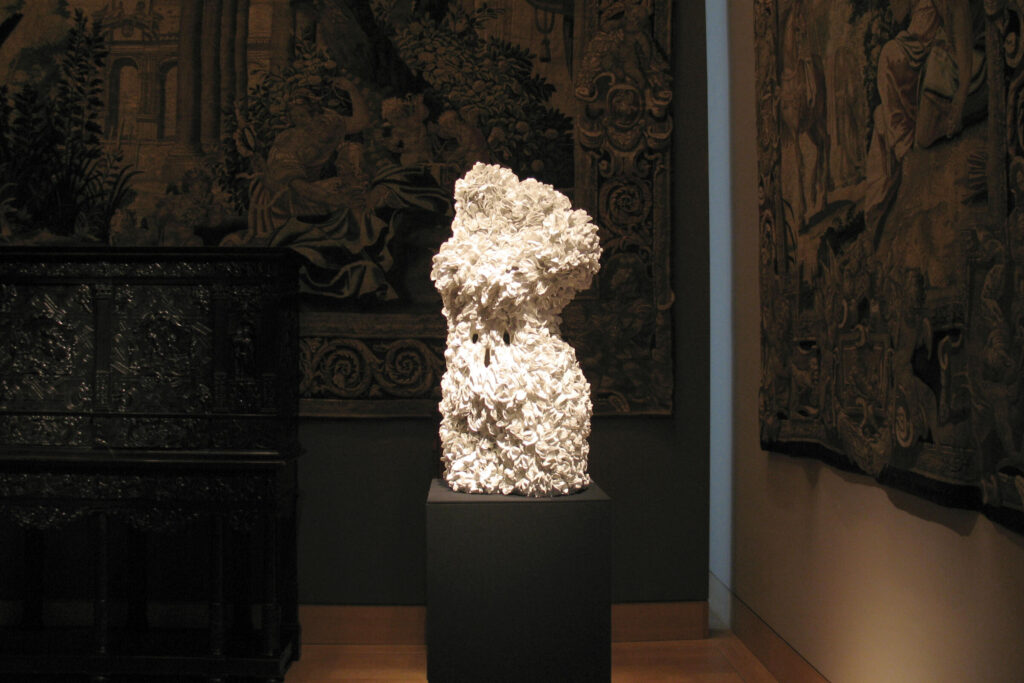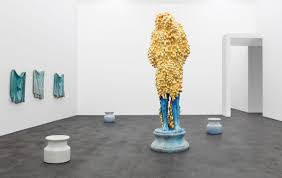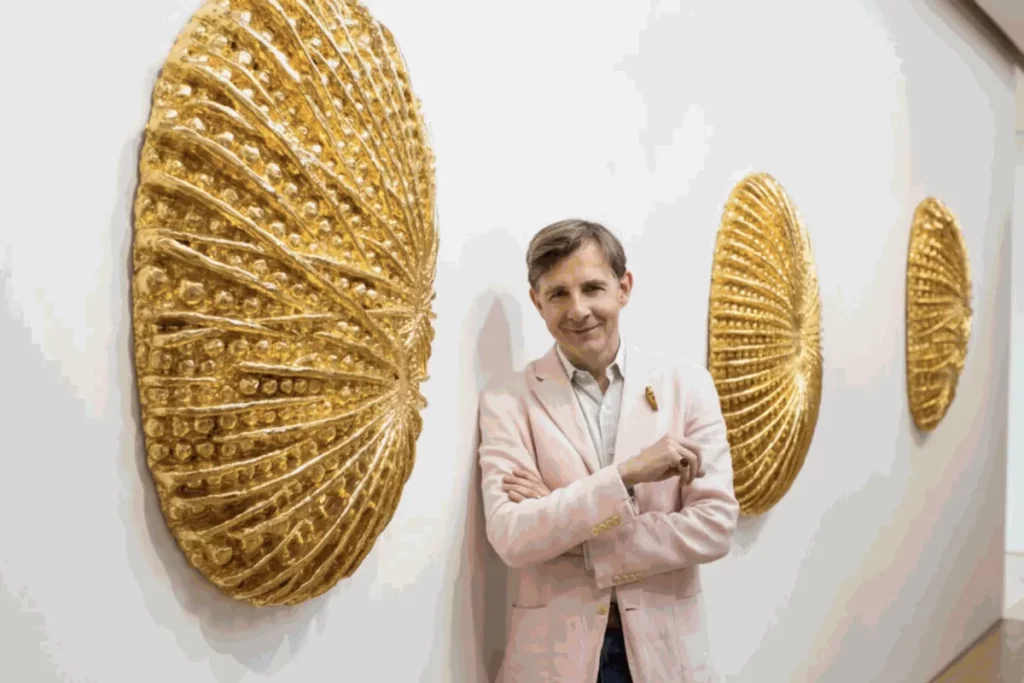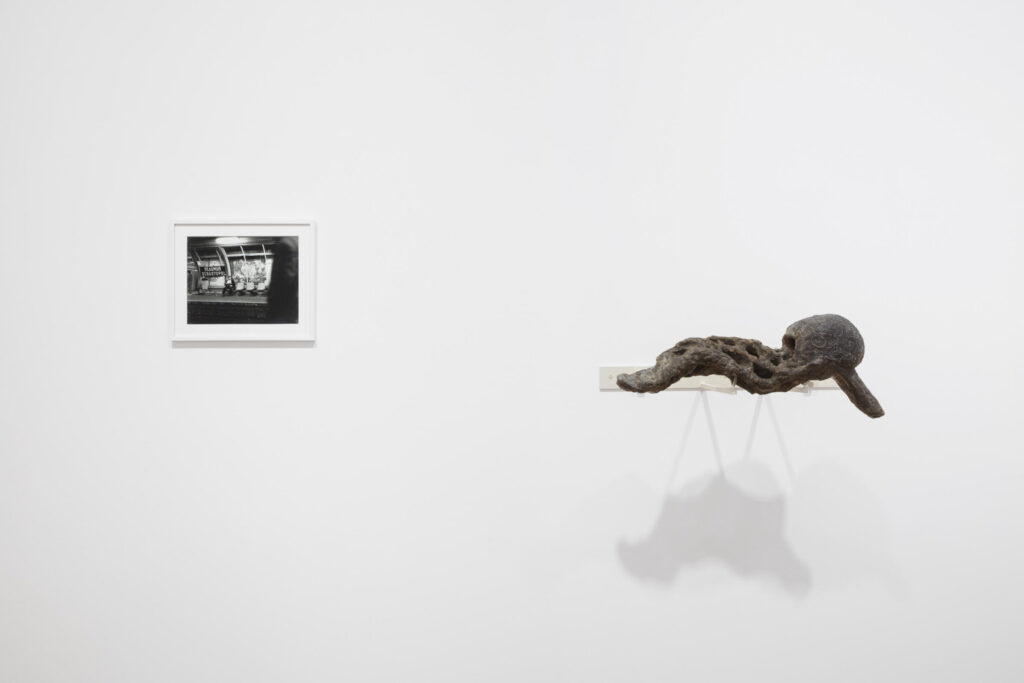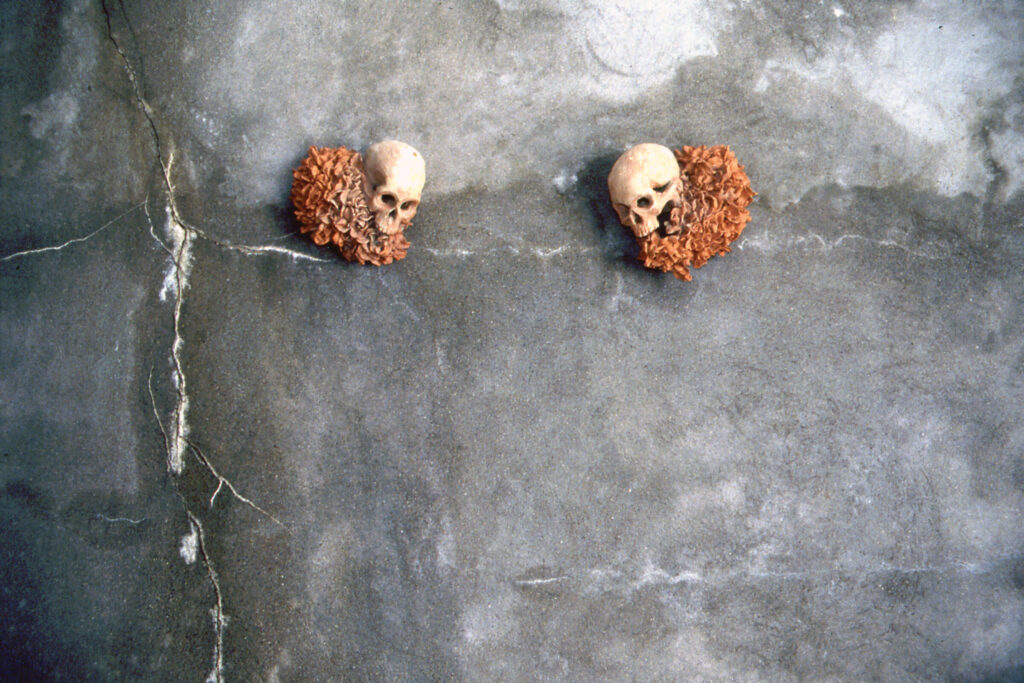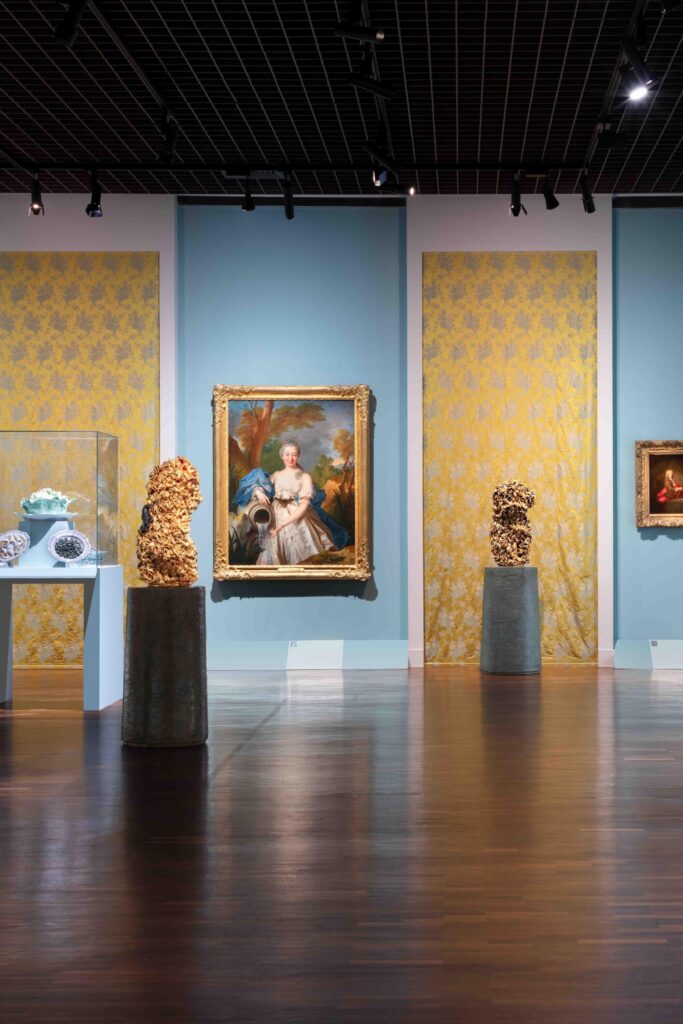
Artist Johan Creten was born in Belgium in 1963. After traveling and living all around the world, Creten currently lives and works in Paris.
Recent exhibitions include at the Musée des Beaux-Arts d’Orléans and Ceramic Brussels in 2024.
interview with interdisciplinary artist johan creten
Born in Belgium in 1963, Johan Creten is a flag bearer of the revitalisation of sculptural ceramics into the fine art realm. Beginning his career as an art student at the Royal Academy of Fine Arts in Ghent, Creten has been exploring and expanding the conceptual framework of sculptural clay for nearly four decades. Creten – along with artists Thomas Schütte and Lucio Fontana – is regarded as one of the pioneers of re-introducing ceramics into the contemporary art world. Creten was one of the artists at the forefront of a developing discourse – symbolic, social and political – around the medium of clay. The artist points out that within the 1980s Belgian art scene, there was little room in the common imagination for a deeper appreciation of ceramics beyond that of its recognised role in the domain of function and craft. Obsessions with technicality, glaze and firing types dominated the world of ceramics – which is not to say that such questions are unimportant within their field – but Creten pushed for the parallel existence of what ceramics could say. A material that could speak to themes of seduction, human interaction, violence and social intolerance. Clay had been largely unobserved in this context, making it an unfamiliar phenomenon that led to his vision being rejected by both the ceramic and conventional fine art worlds. Creten therefore found artistic and philosophical refuge through a nomadic existence. Throughout these travels and across a far-reaching body of work, he invites us to consider the significant implications of clay in myriad contexts outside the white cube: when it is exhibited within the serene confines of a monastery, standing alongside the works of High Renaissance master, Bernard Palissy or seemingly imprisoned in the cells of a French port. Such criteria compel us to reflect, unveiling new dimensions and fostering a more nuanced understanding of the medium. As both a disruptor and an innovator, Johan Creten offers a intense conceptual paradigm, reimagining clay as a potent tool for social commentary and discussion. Throughout his career, he has challenged the narrow perception of clay as merely decorative and instead harnesses its potential to engage in a social dialogue that tackles awkward and occasionally confrontational themes.
How did you begin your career as a clay artist?
I was a young painter in Belgium at the art school in Ghent. There were hundreds of painters and so the only studio that was empty, except for two older women, was the ceramic studio. That’s how I ended up joining the ceramic studio and consequently where I first touched clay. I felt a relationship immediately: it was so wet and dirty and soft and immediate – I understood there to be a great capacity for expression. This is a basic idea, but when you’re a young artist, and you touch clay, you understand this potential to be very different from all the conceptual discourse that was going on at that time in the art world.
The second thing that I noticed was that nobody, or almost nobody, was working with clay in the art world. People were actively working with ceramics, but globally there was a noticeable gap – it was the ceramics ghetto. This gap existed because the ceramic world was heavily focused on all the technical discussions – about firing, clay type, glazes and oxidisation etc. There was no real discussion about the symbolic importance of clay or the political implications, the social things you could do with it and so on. So I felt that there was a need to do something there.
Can you describe the nomadic element in your work?
I didn’t feel like there was really ever a suitable platform for my art. Exhibiting or selling my clay-based works seemed limited to the ceramic scene, yet my innovative concepts were often misunderstood. For instance, my exploration of incorporating resin and straw into broken ceramic pieces, was far beyond the more narrow vision of decorative ceramics. As a result, I decided I had to travel, from one place to another, in search of spaces where my artistic vision had space to be explored and better understood.
I managed to get a curator from La Villa Arson, a major place for conceptual art in the south of France, to see my work. They had said, ‘Nobody’s doing anything with this thing – do you want to come?’ So I spent a few months at the Villa where they had a ceramic kiln. From then on, I found that other opportunities around the world would come my way. For example, one night at La Villa Arson, somebody mentioned the Kohler Arts Center, in Wisconsin. So I picked up the phone, spoke to Ruth deYoung Kohler and she said, ‘when do you want to come and do something?’ So I bought my plane ticket and flew there.
After I spent a summer in Kohler, I met somebody who said ‘Look, we want do a show of your work in Miami.’ I said, ‘I don’t have a studio.’ So they said, ‘We’ll buy a studio and you can come work here.’ And that’s how Robert Miller invited me to Miami. So, being a nomad was in a way, a way to survive. It was a way that allowed me to continue to make the work that I wanted, to create without any restrictions. But it was also a way of leaving the ceramics ghetto and a very small country. Belgium is fantastic, but it is a very, very small, art scene in a sense. A very active art scene, but very small.
What would you say are some of your earliest themes in your work?
Big questions, big concepts – something that was very far from the typical discourse surrounding ceramics. Ceramics, you will talk about what type of clay, what type of firing, what type of form. But you wouldn’t talk about, what is the meaning? What is the sense, what are we doing? What moment in time are we making in? These are all big questions when you’re an artist that I attempted to tackle early on in my career.
One of my first shows in the 1980s, was at a gallery run by Antony Meyer, the world’s leading expert in Oceanic art. As a young art student, I visited his gallery, and one day he said, ‘Show me what you do.’ He saw a connection between my work and the pieces he displayed, so he offered me an exhibition. I held a show at his gallery of tribal Oceanic art, located on one of the main streets in Paris, alongside many major galleries. During the day, I would display the ceramic sculptures in the gallery. But at night, after the gallery closed, I would take one of the works in my arms and spend the night walking through the streets of Paris with it. I treated the pieces like I was carrying a baby, or perhaps a weapon, among other interpretations. This performance had a strong connection to the works of Joseph Beuys and Franz West, who also engaged in similar performances. So it was clay being used outside the box of the traditional art museum.
In the evolution of your career, how have you observed the medium of clay aligning with or diverging from the contemporary art scene?
I found a necessity to exhibit outside of the traditional spaces of the art world. My need to innovate like this arose from the limitations of traditional art spaces in the 80s and 90s. The white cube galleries of that era didn’t grasp the significance of my work, dismissing it as merely decorative. This perception was influenced by its visual, tactile and beautiful appeal and the inherent associations of clay with the decorative realm of ceramics.
So the only place I could show my work was in ulterior spaces, like historical spaces. For instance, in the Louvre in Paris I once showcased my work in conversation with the Renaissance master ceramicist, Bernard Palissy. Palissy’s Renaissance ceramics stand as more than decorative pieces – they are profound reflections on transformation. While his vibrant use of colour marked a departure from typical brown medieval pottery, his works, adorned with snakes and frogs, speak to a deeper narrative. Both the snake and the frog, symbolise metamorphosis – a theme echoing Palissy’s interest in alchemical transformation. Just as he sought to transform mud into vibrant glazes, his art embodies the Renaissance obsession with unlocking nature’s secrets, similar to the pursuit of turning base metals into gold. When offered a spot in the Louvre, it wasn’t to be showcased amidst grandeur but to be aligned with Palissy’s legacy – a testament to the enduring quest for metamorphosis and the transformative power of art.
Can you explain your approach to repositioning clay away from the decorative realm of ceramics?
At art school, they said to me, ‘Johan, you’re cerebral’ and that was meant as an insult. But for me, the storytelling part of works is something I’m drawn to. There’s often this big gap between what you see in an art work and what it actually is speaking about, what it means. Most of the time, this gap can be quite dangerous. For example, some of my works, could aesthetically be described as very beautiful pieces, like we discussed earlier. When in fact, the works are representative of very serious issues, often large-scale social taboos. For example, one of my earlier shows was a commentary on the rise of the extreme right in the South of France. We are now thirty or so years on from that and we are still very much in the midst of that same political climate. These were sensitive topics and often awkward to discuss, especially therefore to be discussed in clay.
What is your perception today of this huge increase in interest in ceramic and clay art?
In the current artistic climate, there’s a seeming resurgence of interest in crafts. This is particularly true of the ceramic world. This revival I think is partly a response to a broader movement away from the highly conceptual art of recent times, towards a more hands-on, tactile approach. Art schools now embrace a liberating ethos, allowing artists to explore diverse materials without constraints, such as photography, ceramics and textiles.
However, amidst this resurgence, there’s noticeably a lot of what I term “ceramic blobs” — abstract, formless ceramic creations that diverge from traditional shapes. These pieces gain popularity for their decorative flair and contemporary colour palettes that resonate with today’s world of Instagram and social media. Yet they risk being dismissed as transient trends akin to past phenomena like photography. Furthermore, alongside the renewed interest in ceramics, there’s a disconcerting return to figurative painting. While figurative art certainly has its merits, much of the output feels trapped in a nostalgic echo chamber, lacking the necessary innovation that breaks the fundamental idea that it is a painting on the white cube wall. The concern is that once the current ceramic trend wears off, the medium may regress into obscurity, perhaps except for a select few who manage to transcend its decorative confines. While aesthetically pleasing, there’s a danger of ceramics being relegated to the realm of mere ornamentation rather than celebrated as profound artistic expressions. Even within esteemed art shows such as the Venice Biennale, there’s an undercurrent of conservatism, where attempts at radicalism often come across as contrived. Simply juxtaposing ceramics with other mediums in a superficial attempt at innovation falls short of genuine artistic breakthrough. So I think while there’s an appreciation for the craftsmanship and beauty of ceramics, there’s an urgent need for it to evolve beyond superficial trends. Only then can it maintain its relevance and significance in the ever-evolving landscape of contemporary art.
How drawn have you been over the years to some of the technical aspects of the medium?
The essence of my artistic journey has always been about embracing the materials and environments I encounter. Whether it’s working with red clay in Mexico or white porcelain in Sèvre, or now having a studio outside Paris, the process is ever-evolving. While my recent pieces have leaned towards conceptual shapes, crafted by others in my studio, my core principle remains: I’m the driving force behind my art. Yet, having a studio for a year has shifted my focus. Instead of immersing myself solely in the process, I’m often preoccupied with what’s next. I despise the notion of simply “producing” another show; it reduces art to a commodity. Today’s art scene often prioritises replication over innovation. Unlike those who plan projects meticulously beforehand, I prefer to let my creations unfold organically. I work at my own pace, resisting pressure from galleries to adhere to deadlines. The creative process isn’t linear; it’s filled with moments of doubt and discovery. Despite the challenges, museum exhibitions have allowed me to reflect on my journey, rediscovering forgotten ideas and reigniting my passion. It’s about keeping the flame alive, even when the path ahead seems unclear.
“I found it necessary to exhibit outside of the traditional spaces of the art world. My need to innovate like this arose from the limitations of traditional art spaces in the 80s and 90s. The white cube galleries of that era failed to grasp the significance of my work, dismissing it as merely decorative. This perception was influenced by both its visual, tactile, beautiful appeal and the inherent associations of clay with the decorative realm of ceramics.
[Johan Creten in conversation with Art Formes]

